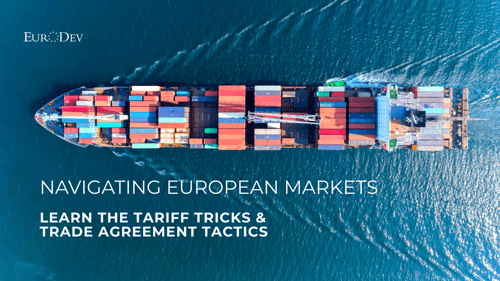State of Renewable Energy Industry in Europe
Europe is leading the way when it comes to renewable energy, with ambitious targets set for the coming years to continue the shift towards a greener future. It is resulting in the developing of various substitutions to original energy sources based on the unique characteristics of individual countries.
In this article, we will deep dive into the current state of renewables across Europe and the goals set by the European Union (EU) to accelerate the transition to a low-carbon economy.
Current State of Renewables in Europe
Renewable energy has seen significant growth in Europe over the past decade. In 2022, renewables accounted for 37% of Europe's electricity generation, up from just 21% in 2010 and it is predicted to reach 69% in 2030 by EU Commission. Wind power is the largest contributor to this figure, followed by solar and hydropower. At the same time, fossil fuel supply disruptions have underlined the energy security benefits of domestically generated renewable electricity, leading many countries to strengthen policies supporting renewables.
Several countries in Europe are also leading the way in terms of renewable energy production. For example, in 2020, more than 60% of Denmark's electricity was generated from wind power, while Iceland generated almost 100% of its electricity from renewable sources, primarily geothermal and hydropower.
Solar and wind power generated more than a fifth (22%) of the electricity in 2022, pulling it ahead of fossil fuels (20%) for the first time. Solar power in Europe records increased results every year, so in 2022. it grew by almost 50%, solar provided 12% of the EU power during summer and for the first time in history, it exceeded 10%.
20 European countries sourced a record share of their power from solar in 2022. Some of the leading countries in Europe when it comes to solar power are Germany, Italy, Spain, France, and the Netherlands. Nine EU countries reported more than half of their total energy generated in 2022. was from renewable sources. This is the same number as in 2021, but many of the countries further increased their renewables output. Leading the pack is Luxembourg, where renewables generated 86% of electricity last year.
No other energy source is growing as quickly or reliably as solar and it is said that it will continue to play a significant role to compensate for shortfalls caused by the energy crisis caused by the war conflict in Ukraine.
It is worth mentioning that in 2022. extreme droughts hit Europe, so it resulted in the lowest hydropower generation in more than two decades. A drop is also recorded when it comes to nuclear power generation and most of the reduction was caused by the French nuclear plants' outages. It is expected that both hydro and nuclear power are expected to recover.
The use of renewable energy in the transportation sector is also on the rise. Electric vehicles (EVs) are becoming increasingly popular in Europe, with Norway leading the way with the highest number of EVs per capita in the world. In addition, several European countries have set ambitious targets for the phasing out of fossil fuel vehicles, with Norway aiming for 100% zero-emission vehicle sales by 2025 and the UK and France targeting a ban on new gasoline and diesel vehicles by 2030.
Goals for Renewable energy sources in Europe
The EU has set ambitious targets to accelerate the transition to a low-carbon economy and combat climate change. These targets were established in the Clean Energy Package, which was adopted in 2019 and includes the following goals:
- 32% share of renewables in the EU's final energy consumption by 2030
- 40% reduction in greenhouse gas emissions compared to 1990 levels by 2030\
- 32.5% improvement in energy efficiency by 2030
In addition to these targets, the EU has established a long-term goal of achieving net-zero greenhouse gas emissions by 2050. This goal was enshrined in the European Climate Law, which was adopted in 2021 and makes the EU the first major economy to legislate for net-zero emissions.
To get these up to speed, the EU Commission unveiled a plan to end a reliance on Russian fossil fuels before 2030. and rapidly reduce its dependence on non-renewable energy sources.
To achieve these goals, the EU has implemented several measures to support the growth of renewable energy. These include the establishment of a European Green Deal Investment Plan, which aims to mobilize at least €1 trillion in public and private investment over the next decade to support the transition to a sustainable and carbon-neutral economy. The EU has also established the Clean Energy for All Europeans package, which includes new rules to facilitate the development of renewable energy sources and the deployment of new technologies.
Conclusion
Renewable energy is on the rise in Europe, with several countries leading the way in terms of production and consumption. The EU has set ambitious targets to accelerate the transition to a low-carbon economy and combat climate change and has implemented several measures to support the growth of renewable energy. While there are still challenges to overcome, such as grid integration and the intermittency of some renewable energy sources, the progress made so far is encouraging and provides hope for a more sustainable and equitable future.
About EuroDev
EuroDev was established in 1996 in the Netherlands with a single, defined purpose to help mid-sized North American companies expand their business in Europe. So far, we have partnered up with over 500 companies and helped them define and meet their European business goals. Services provided include Sales Outsourcing, HR Outsourcing, and Digital Marketing.
Category
Related articles
-

Guide: Navigating Tariffs and Trade Agreements in Europe
30 January 2024By understanding the market dynamics and optimizing tariff strategies manufacturers can position...
Read more -

Interview: Becoming a NATO supplier with Vicente Gonzalez
29 November 2023Vicente Gonzalez provides invaluable insights into the challenges and prospects for North American...
Read more -

Strategic Insights: Market Entry for North American Tech Manufacturers in Europe
29 November 2023Buckle up, because we're about to embark on a strategic journey to decode the keys to successful...
Read more

